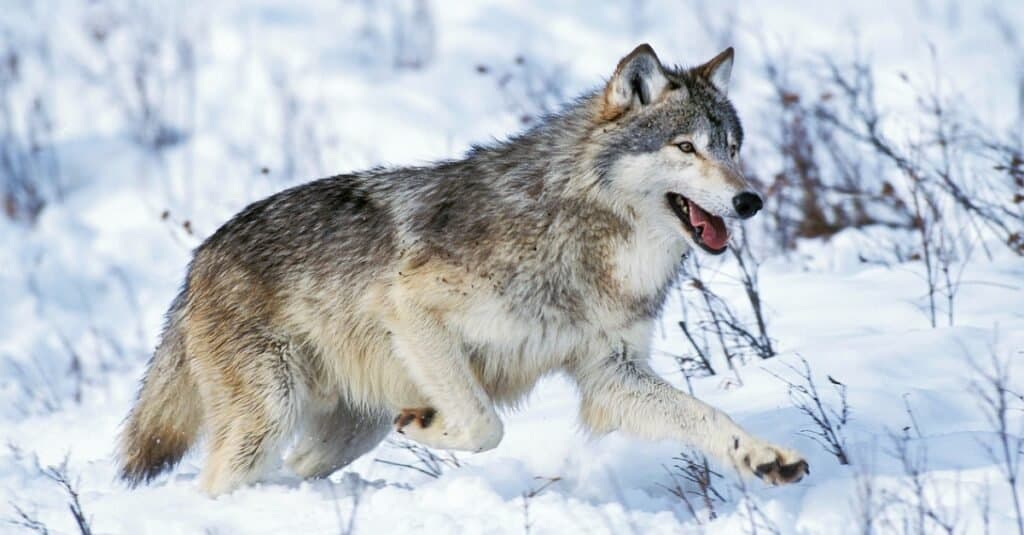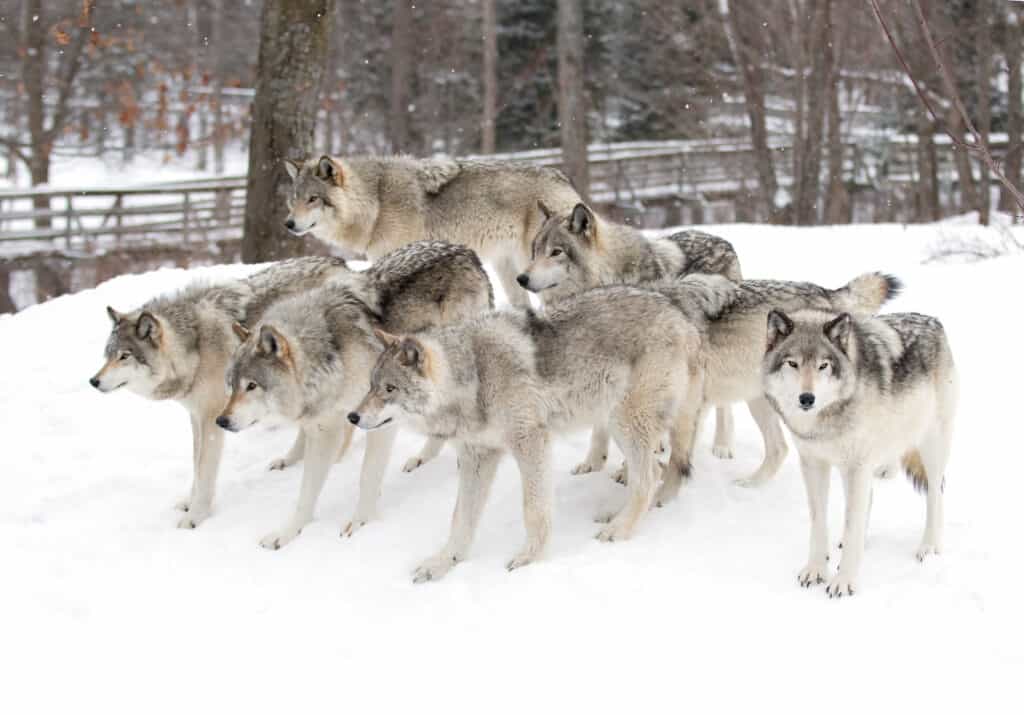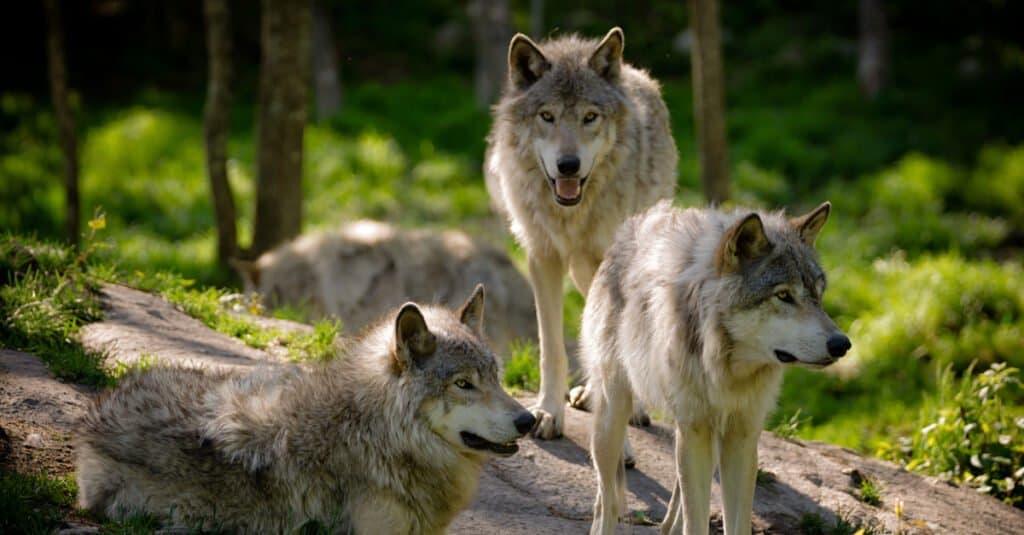Canada is a country of vast wilderness and some of the largest game in the world, including wolves. Today, we are going to take discover how many wolves live in Canada, their historic range, and where most live. Let’s get started.
How Many Wolves Are in Canada?

Gray wolves are elegant predators and highly social animals that form tight, nuclear packs.
©iStock.com/slowmotiongli
There are between 50,000 and 60,000 wolves that live in Canada.
Canada is home to the world’s largest wolf population, with more than 50,000 wolves roaming the huge expanse and varied landscapes of the country. Wolves are in almost every province and territory except for New Brunswick, Nova Scotia, and Prince Edward Island.
Since the wolf population is so large, especially when compared to the rest of the world, the country has become an important sanctuary for the recovery of the species that was nearly wiped out in many places they once thrived. As wolves were pushed north out of the United States, Canada’s massive wilderness regions allowed the wolves to rebound.
Canada’s Wolf Population History

Timber wolves or grey wolves Canis lupus timber wolf pack standing in the snow in Canada.
©Jim Cumming/Shutterstock.com
Wolves have been living in Canada for thousands of years, long before humans arrived. They were once widespread across the country, occupying almost every type of habitat, from the Arctic tundra to the temperate forests. Wolves were respected and revered by many Indigenous peoples. They had complex relationships with wolves based on mutual understanding and coexistence.
However, with the arrival of European settlers, wolves faced persecution and extermination. They were seen as pests, competitors, and threats to livestock and people. Wolves were hunted, trapped, poisoned, and shot in large numbers, causing their populations to decline drastically. By the early 20th century, wolves had disappeared from most of southern Canada, except for some areas near Lake Superior. Wolves went extinct in some parts of their historic range in the United States, such as California and the Southeast.
Today, wolves have made a remarkable comeback in Canada thanks to conservation efforts and legal protection. They now occupy about 90 percent of their historic range, with an estimated population that could total over 60,000 wolves. Wolves are still absent from some provinces and territories, such as New Brunswick, Nova Scotia, Prince Edward Island, Newfoundland, and Labrador. In addition, they are absent from parts of southern Ontario and Quebec. Some researchers argue that wolves never lived in some of these places, specifically Prince Edward Island. Despite their setbacks, there are signs of wolves expanding their range and recolonizing some of their former habitats. In fact, some reports of wolves venturing into the northeast of the United States occur.
What Species of Wolves Live in Canada?

Gray wolves are the most common species in Canada, but some taxonomists say that the eastern wolf should be split into its own species out from gray wolves.
©iStock.com/GatorDawg
Canada is home to several species and subspecies of wolves, each with their own unique characteristics, adaptations, and distributions. The gray wolf is the most common and widespread species. It features several regional variations, such as the Arctic wolf, the Great Lakes wolf, and the Northwestern wolf.
Although there is often some confusion between subspecies and different species altogether, all of the wolves that live in Canada are technically considered “gray wolves.” That being said, there are physiological differences between the subspecies that are quite noticeable. For instance, the Arctic wolf (the northern subspecies of the gray wolf) has adapted to have thick white fur to keep it warm and better blend in with the snowy north.
There is still some debate as to the exact taxonomy of wolf species in North America, with many researchers still trying to find the best groupings and language to divide by species or subspecies more accurately.
Where Do Most Wolves Live in Canada?

The sparsely populated wilderness regions of the north and western parts of Canada are home to the most wolves.
©Vlada Cech/Shutterstock.com
Wolves are found in almost every province and territory in Canada, except for a few areas where they have been extirpated (pushed or killed out) or never existed. However, some regions have higher densities and larger populations of wolves than others, depending on the availability of prey, habitat, and human activities.
According to a map by the International Wolf Center, most wolves live in northern and western Canada, where there are vast expanses of forest, tundra, and mountains. These areas have lots of prey species, like caribou, moose, elk, bison, and deer, as well as less human disturbance. Some of the largest wolf populations are found in British Columbia, Alberta, Yukon, Northwest Territories, Nunavut, Manitoba, and Saskatchewan.
Some wolves also live in south-central Canada, primarily around the Great Lakes region. These wolves are smaller and darker than their northern cousins, and they feed on deer, moose, beaver, and hare. They are closely related to the eastern wolf, which is a rare and endangered species that lives in southeastern Canada.
The photo featured at the top of this post is © AB Photographie/Shutterstock.com
Thank you for reading! Have some feedback for us? Contact the AZ Animals editorial team.







